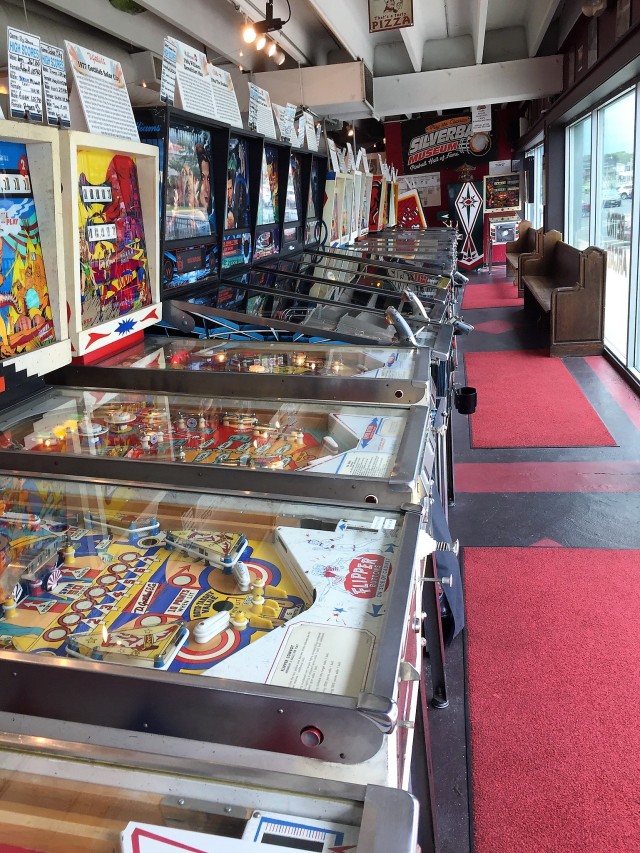
The pinball machine as we know it was not invented as much as it was an evolution of earlier games. The father of the pinball machine was the French game Bagatelle, a game played on a tabletop with marbles. It is believed that the game was first introduced in the United States by French soldiers who were fighting in the War of Independence. The term “pinball” was not used until 1936, but the evolution of the pinball machine started long before than.
In 1871, a Cincinnati inventor named Montague Redgrove won a patent for a spring-based ball shooter that would become the standard way that balls were launched on pinball machines for decades thereafter. The first coin operated machine debuted in 1889. Innovations came fast and furious in the 1930s after the introduction of two enormously popular games, Gottlieb’s Baffle Ball and Bally’s Ballyhoo. In 1933 the first machine utilizing electricity was introduced. One year later saw the advent of the automatic scoring system. And in 1935 Harry Williams created the first tilt mechanism. Prior to that time you moved the ball around the table by shaking, bumping or banging on the machine. (Something I continued to try to do as a teenager in 60’s.)

Gottlieb’s 1950 Knockdown, an example of one of the early flipper machines. Look at the space between those flippers!

5 balls/5 cents. The going rate in the 1950’s. Hawaiian Beauty is a 1954 Gottlieb machine.

Williams’ 1951 Hayburners is another example of an early flipper machine. Note the reverse flippers.

Pinball emerged as a popular pastime in the 1930’s. It was a cheap form of amusement in a country suffering from the Depression. Production of pinball machines slowed during World War II as most of the country’s manufacturing capabilities were focused on the war effort. Interest in pinball spiked in the post war period.
The authorities were not necessarily enamored with this new amusement. In fact some cities, including America’s three largest, banned the pinball machine as a gambling device. While modern day machines reward outstanding performance with free games, during the early years of pinball, prizes, including perhaps a beer or a pack of cigarettes, were awarded by the machines’ host. In the 30’s you might find a pinball machine in a bar, but also in a drugstore, barber shop or gas station.
Fiorello LaGaurdia, mayor of New York City from 1935 to 1944, claimed that pinball “robbed” schoolchildren of the nickels and dimes that they should have used for lunch money. There were also suggestions of mafia involvement. LaGuardia’s enforcers raided pinball halls, seized machines and destroyed them.
What really changed pinball as an entertainment was the invention of the flipper in 1947 by Gottlieb. It was first introduced on the Humpty Dumpty machine. The new flipper machines gave rise to what has been called the Golden Age of Pinball, from 1948 to 1958. The flipper also paved the way for legalization in those areas where the game was prohibited. With the use of the flipper, the argument went, pinball became a game of skill rather than a game of chance. Even so, legalization did not happen in New York, Chicago and Los Angeles until the 1970’s.
There was another new wave of more sophisticated machines in the 1970’s with the advent of the solid state electronic machine. But by the 1980’s, pinball began to decline as the machines began to give way to video games.
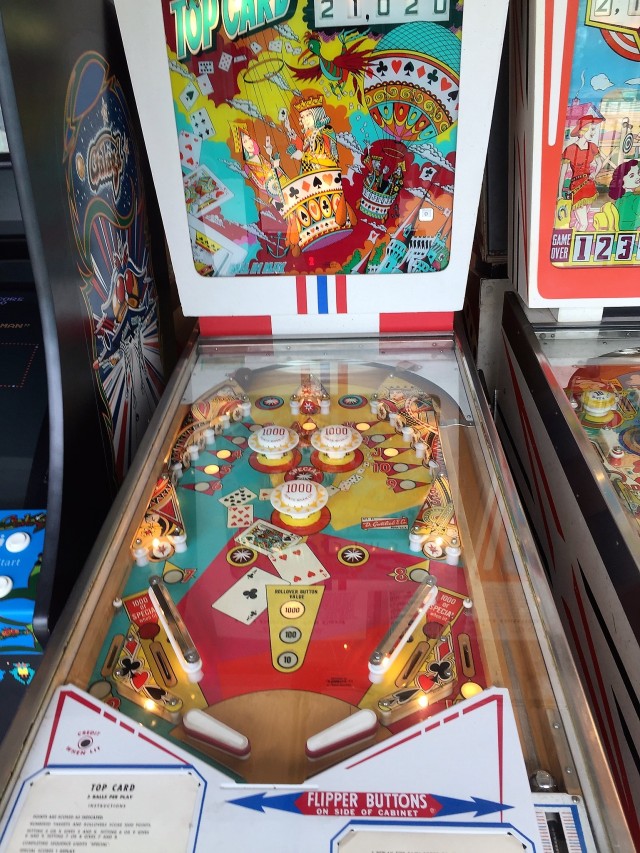
1974 Gottlieb Top Card
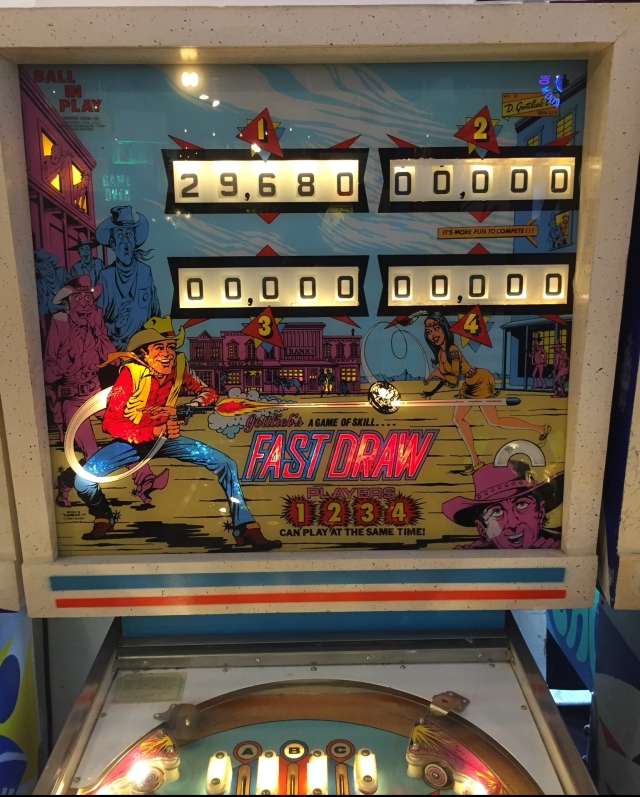
1975 Gottlieb Fast Draw
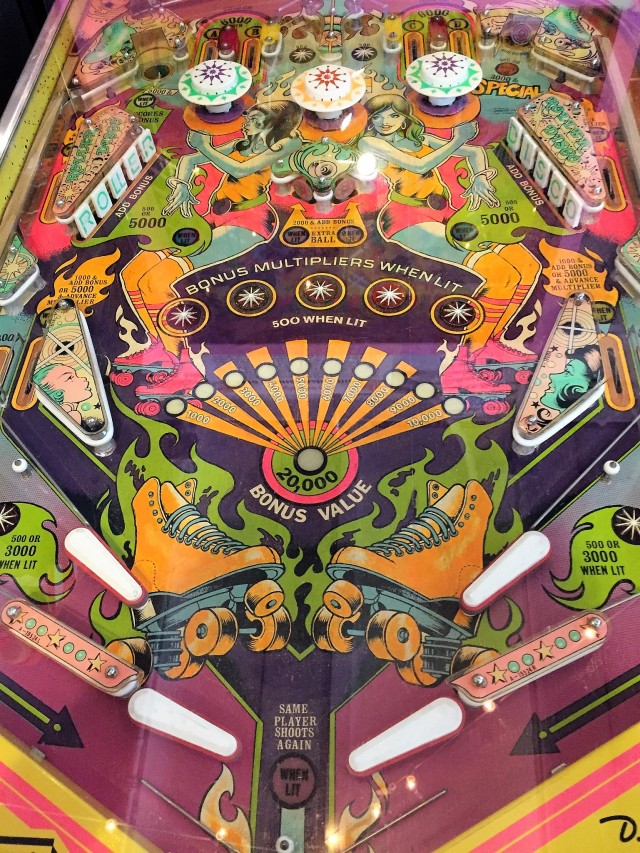
Gottlieb 1980 Roller Disco, an example of a “wide-body” machine,.

Williams 1986 Pin Bot
Three manufacturers, Gottlieb, Bally and Williams, were responsible for most of the country’s popular and innovative pinball machines.
Gottlieb Manufacturing was established by David Gottlieb in 1927. He introduced the first widely popular pinball machine, Baffle Ball, in 1930. It is Gottlieb that produced the innovation that changed the history of pinball, the flipper, in 1947. A few years later they produced the first multiplayer machine, Super Jumbo.
Gottlieb was purchased by Columbia Pictures in 1976. Columbia was later purchased by Coca-Cola and Gottlieb, after being renamed Mylstar Electronics, was closed down in 1984
Gottlieb’s Baffle Ball machine was surpassed in popularity only by Ballyhoo. It is that machine which gave Bally Manufacturing its name when it was founded in 1932. Bally’s contribution to the evolution of pinball included the first multi-ball machine, Balls-A-Poppin, in 1956. The company went into the casino business in the 1970’s. It began operating casinos and amusement parks (purchased Six Flags) and changed its name in 1992 to Bally Entertainment. Williams acquired the pinball division in 1988.
It was Harry Williams who invented the tilt mechanism and introduced it on a machine called Advance in 1935. Eight years later Williams founded the Williams Manufacturing Company. It was acquired by Seeburg, a jukebox manufacturer, in 1964 and renamed Williams Electronics Manufacturing Division. It was sold when Seeburg went bankrupt. It became a public company in 1987 and acquired Bally pinball. The merged entity also made video games and slot machines. The pinball division was closed in 1999. It is Williams that produced the Addams Family, the most popular pinball machine ever, selling more than 20,000 units.
By the turn of the century, only one pinball manufacturer was left standing. Stern Pinball of Chicago, which was founded in 1999, remains in business. Its market has changed so that a substantial part of its business is home sales. There are also a couple small manufacturers that have sprung up in recent years.

Williams’ 1993 Indiana Jones machine added some firepower to the ball shooter. Indiana Jones also included video clips

Williams 1994 World Cup. (The going price is now 50 cents.)
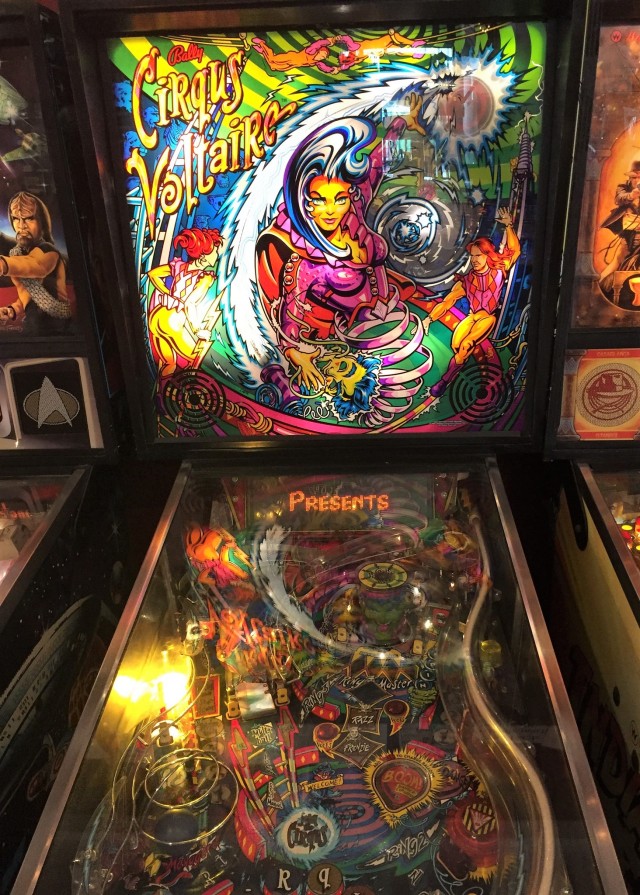
Bally’s 1997 Circus Voltaire was a product of the merged Bally’s-Williams company.
All photos are from the Silverball Museum on the boardwalk in Asbury Park, N.J.


I enjoyed reading about the history of pinball. I didn’t realize it went as far back as it did. I always thought of it as a 1960-70s craze. Although I was never big into pinball, I think the Silverball Museum would be fun to visit.
LikeLiked by 1 person
So interesting!!
LikeLike
Yeah gamers of all kinds including the internet. developers should know their gamer history! Hahaha!!
LikeLiked by 1 person
What an entertaining and interesting read! Thanks for sharing it
LikeLiked by 1 person
You always have such interesting historical details and artful pictures to illustrate them:-)
LikeLiked by 1 person
Thank you.
LikeLike
Amazing articles on the history of baseball and pinball. I have learned a lot of things absolutely unfamiliar to me before.
LikeLiked by 1 person
Liked reading the history of pinball ,I play a lot,
all on PlayStation and Xbox these days
LikeLiked by 1 person
Pingback: Bugs, tilt, zerar: já faz mais de 25 anos – Faz 25 anos
Pingback: Nothing Criminal about Pinball in Chubb Dodge’s | Steve Love